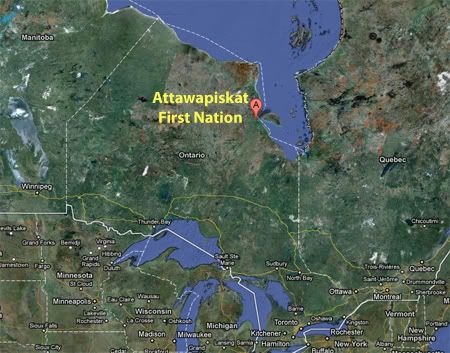
Attawapiskat First Nation office
Credit: Paul Lantz
We thought it important to bring to your attention a troubling crisis in the far north of Canada. We’ve blogged numerous times in the past about various environmental crises in the boreal forest—from worrisome declines in woodland caribou and migratory birds to destructive industrial projects—but this story focuses on a human tragedy, and one that will resonate deeply with anyone concerned about poverty, disease outbreaks, and other cold realities of those less fortunate than many of us are.
Attawapiskat First Nation is a small Aboriginal community in the far north of Ontario, less than 20 miles from James Bay up the Attawapiskat River. Long a place of gathering for indigenous people in the area living off the land, over the past century its infrastructure has grown and today nearly 2,000 people reside there year-round. Unfortunately, the condition that many of these people live in is quite shocking.
In late October Attawapiskat First Nation declared a state of emergency over living conditions in the town. Goods—everything from groceries and clothes to fuel, firewood and building materials—are extremely expensive, largely due to shipping costs. There are also very few jobs. While the large diamond company De Beers operates a multi-billion dollar mine less than 60 miles away, only 100 of the 500 employees are from the First Nation and many have complained about pay inequity. In recent years, members of the First Nation have held protests over the relative lack of revenue sharing from the mine, which is on their traditional land.
This combination has left the community with extremely poor living conditions. Makeshift tents, sheds and trailors make up the living quarters for many of the members, most of which are uninsulated and often lack a heat source despite the temperature being well below freezing during the winter. Some of these homes don’t even have running water and must use buckets for waste. Exacerbated by cold and crowded housing, a high number of respiratory and skin infections have plagued the area.
Video showing the housing crisis:
This is something you’d expect to see in a third world country, not a prosperous Western country like Canada. The government has begun to listen, but some complain that it knew about these conditions long in advance and should have acted sooner. Additionally, some of its more recent approaches to solving the problem have come under scrutiny, including the proposal to place Attawapiskat under third-party management to oversee renovations and improvements. This would force them to pay a hefty $1,300 per day fee for the consultant and would largely remove the government’s direct responsibility for overseeing improvements.
It’s a very tough and complex situation, and one filled with much emotion. Here are a couple of good articles discussing some of the components of the crisis:
Feds aware of Attawapiskat crisis for years:
http://www.cbc.ca/news/politics/story/2011/12/03/pol-attawapiskat-thehouse-strahl-fontaine.html
Attawapiskat’s woes spark debate about what’s wrong on Canada’s reserves:
http://www.theglobeandmail.com/news/politics/attawapiskats-woes-spark-debate-about-whats-wrong-on-canadas-reserves/article2255952/
Attawapiskat Crisis: Reserve Must Pay $1,300 Daily For Third-Party Consultant:
http://www.huffingtonpost.ca/2011/12/08/attawapiskat-crisis-pay-consultant_n_1136665.html?ref=canada-politics
(Op-ed): Rethinking the future of Ontario’s north
http://www.thestar.com/opinion/editorialopinion/article/1098714--rethinking-the-future-of-ontario-s-north
Unfortunately, Attawapiskat First Nation is not alone. Numerous other First Nations across Canada have complained about similar situations—poor housing facilities, water and electricity shortages, and other undesirable conditions—and the issue of living conditions in Aboriginal communities has become much larger than any one of those communities. It’s a problem that must be addressed – we join the call for a renewed and real commitment by government leaders to create thriving, sustainable communities in Canada’s North with a high standard of housing and a quality way of life.


